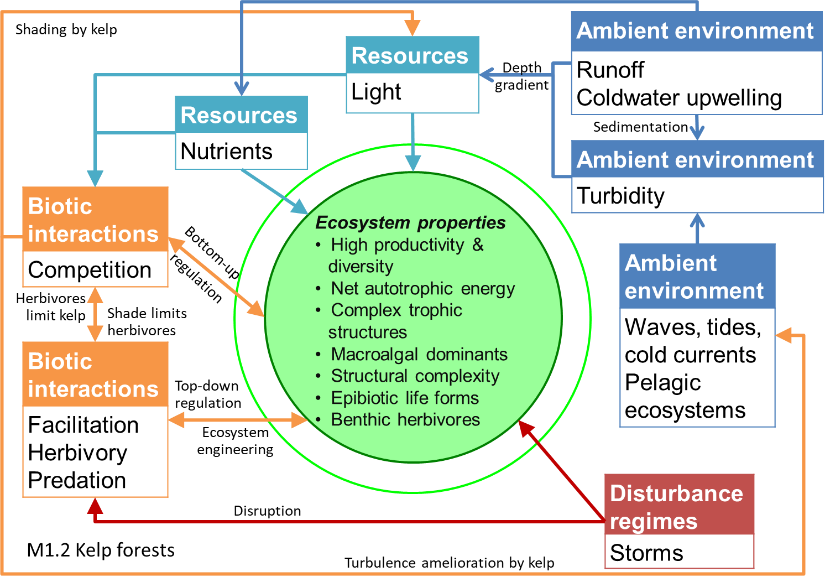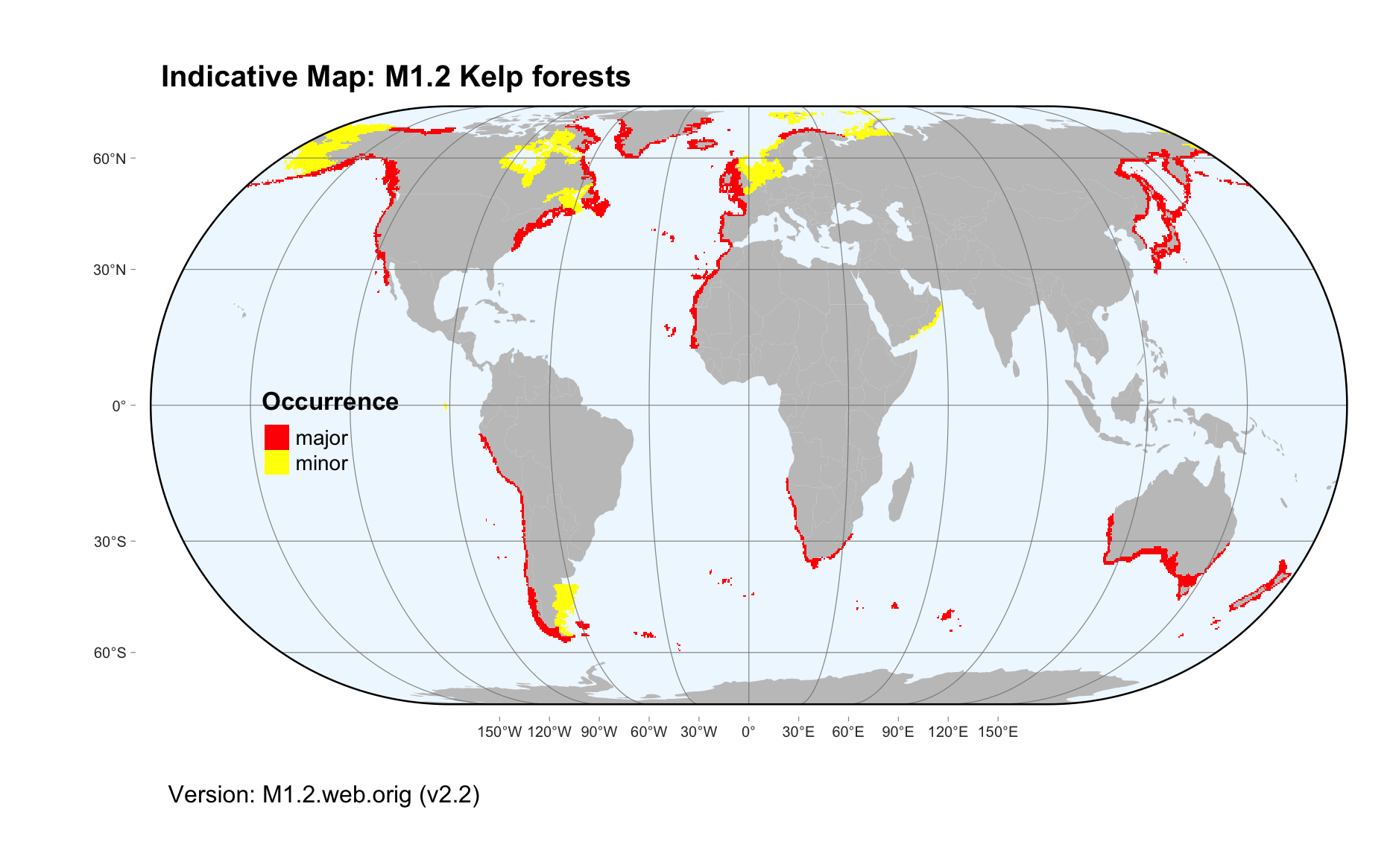Global ecosystem typology
Alternative site for the Global ecosystem typology with additional information for ecosystem profiles and indicative maps.
This site is maintained by jrfep
M1.2 Kelp forests
Biome: M1. Marine shelf biome
Contributors:
(texts)
Kelps (large, brown macroalgae up to 30m in length) form the basis of these highly productive systems found on shallow, subtidal rocky reefs around cold temperate and polar coastlines. Their forest-like structure and vertical habitat supports diverse epiflora and –fauna living on the kelp itself, as well as rich communities of invertebrates, fish and marine birds and mammals living and foraging in and around these ecosystems. High nutrient requirements mean these ecosystems are often associated with upwelling water, while wave action and currents are important for replenishing oxygen.
Key Features
Hard subtidal substrates in cold, clear nutrient-rich waters with dominant brown algal macrophytes, associated epibiota, benthic macrofauna, fish & mammals.
Overview of distribution
Cool temperate coastal waters or regions receiving cold currents.
Profile versions
- v1.0 (2020-01-20): DA Keith; MJ Bishop; EJ Gregr
- v2.0 (2020-05-27): DA Keith; MJ Bishop; SN Porter; EJ Gregr
- v2.01 ():
- v2.1 (2022-04-06): DA Keith; MJ Bishop; SN Porter; EJ Gregr Full profile available at official site
Main references
Selected references for this functional group:
Bennett S, Wernberg T, Anderson RJ, Bolton JJ et al. (2015) Canopy interactions and physical stress gradients in subtidal communities Ecology Letters 18: 677–686 DOI:10.1111/ele.12446
Steneck RS, Graham MH, Bourque BJ, Corbett D, Erlandson JM, Estes JA, Tegner MJ (2002) Kelp forest ecosystems - biodiversity, stability, resilience and future. In: Environmental Conservation 29: 436–459.
Diagrammatic assembly model

Maps
Maps are indicative of global distribution patterns are not intended to represent fine-scale patterns. The maps show areas of the world containing major (coloured red) or minor occurrences (coloured yellow) of each ecosystem functional group. See general notes on maps.
There are 2 alternative versions of the indicative map for this functional group, please compare description and sources below.
M1.2.IM.orig_v2.1
Datasets
- MEOW-2008
- SRTM30-PLUS-V11
- Kelpforest-list
Map references
Spalding MD, Fox HE, Allen GR, Davidson N, Ferdaña ZA, Finlayson M, Halpern BS, Jorge MA, Lombana A, Lourie SA, Martin KD, McManus E, Molnar J, Recchia CA, Robertson J (2007) Marine ecoregions of the world: a bioregionalization of coastal and shelf areas. Bioscience 57: 573–583. DOI:10.1641/B570707
Becker JJ, Sandwell DT, Smith WHF, Braud J, Binder B, Depner J, Fabre D, Factor J, Ingalls S, Kim S-H, Ladner R, Marks K, Nelson S, Pharaoh A, Trimmer R, Von Rosenberg J, Wallace G, Weatherall P (2009) Global Bathymetry and Elevation Data at 30 Arc Seconds Resolution: SRTM30_PLUS, Marine Geodesy 32: 355-371. DOI:10.1080/01490410903297766
Wernberg T, Filbee-Dexter K (2019) Missing the marine forest for the trees Mar Ecol Prog Ser 612:209-215 DOI:10.3354/meps12867
M1.2.web.orig_v2.2

Datasets
- MEOW-2008
- Kelpforest-list
Map references
Spalding MD, Fox HE, Allen GR, Davidson N, Ferdaña ZA, Finlayson M, Halpern BS, Jorge MA, Lombana A, Lourie SA, Martin KD, McManus E, Molnar J, Recchia CA, Robertson J (2007) Marine ecoregions of the world: a bioregionalization of coastal and shelf areas. Bioscience 57: 573–583. DOI:10.1641/B570707
Wernberg T, Filbee-Dexter K (2019) Missing the marine forest for the trees Mar Ecol Prog Ser 612:209-215 DOI:10.3354/meps12867
Check: the Glossary / Profile structure / the public document